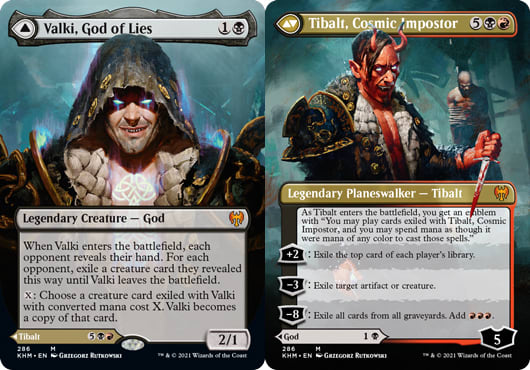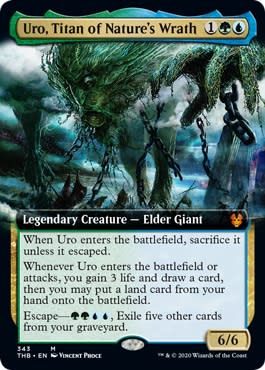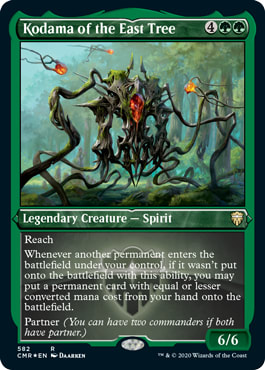It's well-known that Commander began as a community-driven format, literally created in hotel rooms by judges at GPs. The format grew from there to the wider tables and before long the switch was flipped and it was everywhere. EDH caught on with a bang, and you can be sure that Wizards of the Coast won't miss an opportunity to cash in on a popular way to play their game.
Conscious of the fact this necessary intrusion into a community format could be problematic, Wizards of the Coast rightfully treaded lightly when they created "Commander" in 2011. The first wave of Commander decks had some fun group-oriented abilities (like Collective Voyage), while they also introduced some classic leaders like Kaalia of the Vast and Animar, Soul of Elements (plus my personal favorite Karador, Ghost Chieftain).
This signaled a big change in Magic design. Before the shift that the original Commander decks signified, there wasn't much of a rhyme or reason to how cards treated multiplayer variants. Some cards would randomly hit all or each opponent while others would target. Some effects would work through a shrouded or hexproof opponent while others wouldn't. All in all, it was an inconsistent experience.
So Wizards acknowledging that so many people were playing multiplayer games was great for fixing all of those things. But sometimes you get exactly what you asked for, as the Sylvan Primordial / Prophet of Kruphix odyssey demonstrated. Both cards were simply way too much at the time and probably still would be, despite the massive influx of powerful cards we've seen over the years.
Which brings me to the 2020 Test. Like they did originally with the Primordial cycle, Wizards has continued to push and evolve its wording through the years, tweaking and fine-tuning how it works in Commander. As the designs have gone truly off the rails (in a good way) with things like Companions, Commander as a format has had to deal with the fallout, so there's definitely been a few bumps along the way, but the place we're at now with multiplayer design is lightyears ahead of where it's been previously. 2020 is the year of Commander, according to Wizards, and it stands as the year that everything really got ratcheted up a few levels.
Take Inniaz, the Gale Force, for example.
A powerful card, yes, but a large part of Inniaz's power isn't in its mana cost or power toughness box. Heck, it's not even in stealing things - it's in how it steals things. Read again: "each player gains control of a nonland permanent of your choice."
There's a notable word missing there: target. In the first 25 years or so of Magic design, that ability would have targeted permanents, which means it would have gone on the stack and given players the opportunity to respond or sacrifice the selected permanent or whatever. Instead, Inniaz just does its thing, and there's nothing you can do about it once that ability resolves. I'm not here to talk about whether or not removing this point of interaction is good or bad, but it's undeniable that it makes cards more powerful. Like Roiling Regrowth is a Harrow where you can't get punished, cards like Blood for Bones have begun saying things like "return a creature card" instead of "target creature card." This seemingly small design change makes a whole class of cards much better, and that has been acutely felt in Commander. Basically, more cards just do their thing now, adding some really interesting new wrinkles to games - being forced to respond to Inniaz without knowing what it's going to grab certainly adds a different element of gameplay that some players may like and others may not.
You may refer to it as the Korvold, Fae-Cursed King problem, where the cards just do everything so completely you can never prevent it, or you may not consider it a problem at all. But either way it's been a subtle power shift that has changed the bar for what I look to include in my decks - it has certainly encouraged me to read cards more carefully since such small changes to wording can make such big changes in power.
Today I want to look at three standout Commander cards from the last year that clear the 2020 Test. It's not just about power level, so no Hullbreacher and Opposition Agent, but rather cards that benefit from specific, newer wording.
This card is a piece of art. This may be the most pushed wording we've ever seen on a planeswalker card, proving that there are so many more ways to make these things ridiculously powerful without even touching on the loyalty abilities. But while Valki, God of Lies may have enjoyed a brief run helping to break Modern, it's really nicely designed for Commander. It takes into account so many of the things we've mentioned, and it really helps to make it worth sinking mana into a planeswalker, something that you rarely get to untap with at a Commander table.
Not that you plan on this side much, but Valki hits each opponent - that's a three-card exile at a typical table for just 2 mana. Of course they can get the cards back, but you may have turned your Valki into an Oracle of Mul Daya or something by then, since players usually spend the first few turns setting up rather than interacting.
But the backside of Tibalt, Cosmic Impostor is where the 2020 Test really comes into play. I want you to very closely read the emblem you get upon arrival. For starters, you get an emblem instead of it just being a static ability on Tibalt as we might have seen in the past. What it means is that even if Tibalt is killed immediately, just one plus activation is going to give you access to four cards. We've seen free spells tied to permanents before, but Tibalt takes Gonti, Lord of Luxury and pushes it to the max. It's a perfect example of how Commander-acknowledging design has changed.
I know most of us are familiar with Uro, Titan of Nature's Wrath from pretty much, well, everything, but the reason it broke Standard and Pioneer and Historic and Modern and has found a home in Legacy is because it basically established the 2020 Bar, coming out in January and showing us the power level of what was to come.
Uro just does it all, but what I want to call attention to here is the wording of its second ability (the draw/ramp ability). It specifically has you draw the card first, then ramp if you can. It was the best play any turn of the game you could make it. On a giant recursive creature, that was too much for competitive formats.
But for Commander, Uro (like Oko before it) actually hits pretty well. It's in the running for the most Simic Simic card in Commander, and it straddles the line between Rampant Growth variant and threat closely. It's still enormously strong (and obnoxious as a commander), but it's also a great demonstration of the abundance of riches we have from our ramp options now. I used to play "fun" ramp spells like Recross the Paths, and as someone who likes to optimize their decks within reason, I've had a lot of hits like Uro from the last few sets that have shaken up my decks.
I don't think people fully realize how truly absurd this card is - they see Partner on it and assume it's medium power since it's meant to be paired with another commander. But the truth is Kodama is busted as a commander or in the 99, because it has some of the most 2020 wording of all - nowhere does it mention "nonland permanent." Nor does it specify that the card you put into play off the ability must be strictly lesser; it can also be equal. And the Spirit has reach, because why not?
This is all kinds of 2020 wording that you simply won't find on older cards. Any permanent entering triggers it? Every land drop I make comes with a second one? Okay, so Kodama of the East Tree is a mini-Azusa. Oh, it doesn't require the spells to be cast from your hand ala Sunbird's Invocation? And I can trigger it as many times as I can in a turn instead of just the first each turn?
There are so many small changes that could have been made to this card, but in Commander in today's environment we see nearly every ability we've seen over the years pushed to the max, and if you're someone who likes to keep their decks updated I would suggest taking a deep dive through Commanders Legends and Commander 2020 and Commander 2021. There are a ton of small changes like these on cards that really up their power level even in relation to cards we consider staples.
Thanks for reading,

























